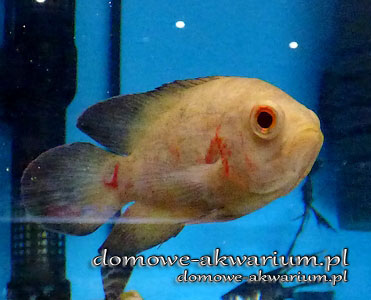
| Gatunek | Oscar Fish |
|---|---|
| Nazywany też | Velvet Cichlid |
| Nazwa łacińska | Astronotus Ocellatus |
| Rodzina | cichlids |
| Występowanie | Ameryka Południowa |
| Długość | 40 cm |
| Temperatura | 22 - 27°C |
| Twardość wody | soft - medium hard |
| pH | 6.0 - 8.0 |
| Zbiornik | 300 L |
| Pokarm | szystkożerne |
Oscar fish, velvet cichlid, tiger oscar, marble cichlid
A freshwater species that in natural conditions inhabits slow-moving or stagnant waters within the entire Amazon region in Peru and Brazil - its basin, streams, brooks, channels, floodplains, seasonal ponds, and lakes. It prefers shallow waters with sandy or muddy bottoms, where it finds a certain kind of cover (tree roots, plants, etc.). The species has been artificially introduced to waters in Asia and North America.
The oscar fish is characterized by a laterally compressed body, thick, fleshy lips, pharyngeal teeth, and a specific construction of the dorsal and anal fins - with partially branched rays (this feature is particularly visible in the case of the dorsal fin, where the first rays stand up like a mohawk). Due to the variety of habitats occupied in nature and selective breeding, there is a whole range of color variations of this species for sale. The basic version has an olive-black or brownish body color with irregular orange-red spots and a characteristic spot at the base of the tail – round, black with an orange margin, resembling an eye. This spot is meant to confuse potential predators who mistake its tail for its head. Commonly available are also marble, red, albino, or veil-tail versions. Young fish are characterized by a gray-black body color with white-cream spots and stripes. The male may be slightly larger and more brightly colored compared to the female. The female, in turn, has a visible (enlarged) genital opening during the spawning period.

The oscar fish is peaceful and likes to dig in the substrate. However, due to its size, it should not be kept in the same aquarium with much smaller fish. Very aggressive fish should be avoided. Its behavior changes somewhat during the spawning period – it becomes territorial and more aggressive, especially males. These fish should not be fed mammal or poultry meat or overfed (they are gluttonous) – as this risks serious digestive system diseases. This species is intelligent, amusing, easily attaches to its owner, and also enjoys playing with things like ping pong balls.
The species requires a spacious aquarium, with sandy substrate (it likes to dig in it and rest at night "suspended" above it), hiding places among roots and branches, subdued lighting (bright lighting increases aggression in these fish), effective filtration. Regular partial water changes, a tight lid are necessary. Care should also be taken with the placement of the heater in the tank. It is best to use an external heater, as there have been cases of this device being broken by the fish. If we plan to have plants in the aquarium, we should properly protect their roots. However, it should be noted that those delicate with soft leaves may be eaten.
An oviparous species. Pairs form spontaneously from the flock and create lasting bonds. To spawn, it is best to choose an already paired couple. The female lays eggs on a flat surface placed on the bottom of the aquarium - most often a stone or branch. Before spawning, this surface is thoroughly cleaned by the future parents. The female lays white, sticky eggs, even up to 2000 pieces (appropriate space is required for this). The parents take care of and protect their offspring. The fry hatch after 3-4 days and are transported by the parents to a previously dug hole in the substrate, where they remain for the next week.